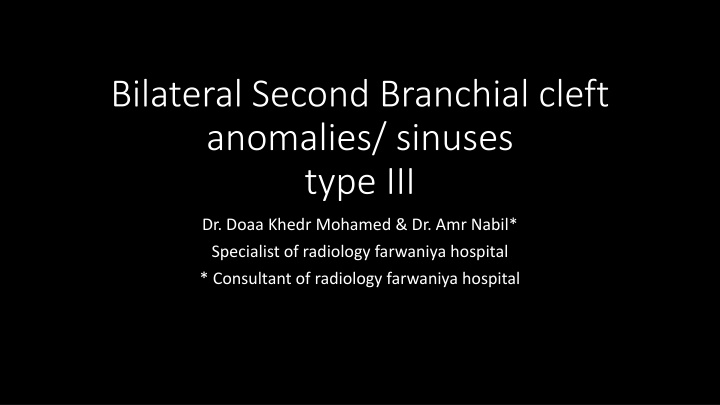
Branchial Cleft Anomalies: Type III Sinuses in a 4-Year-Old Diabetic Female
Explore bilateral second branchial cleft anomalies with type III sinuses in a 4-year-old diabetic female through CT and MRI imaging. Learn about the presentation, classification, and imaging findings of these anomalies extending to the pharyngeal mucosal space.
Download Presentation

Please find below an Image/Link to download the presentation.
The content on the website is provided AS IS for your information and personal use only. It may not be sold, licensed, or shared on other websites without obtaining consent from the author. If you encounter any issues during the download, it is possible that the publisher has removed the file from their server.
You are allowed to download the files provided on this website for personal or commercial use, subject to the condition that they are used lawfully. All files are the property of their respective owners.
The content on the website is provided AS IS for your information and personal use only. It may not be sold, licensed, or shared on other websites without obtaining consent from the author.
E N D
Presentation Transcript
Bilateral Second Branchial cleft anomalies/ sinuses type III Dr. Doaa Khedr Mohamed & Dr. Amr Nabil* Specialist of radiology farwaniya hospital * Consultant of radiology farwaniya hospital
4 year old diabetic female with recurrent sinus on the skin for about 1 year. She performed CT and MRI for assessment. Then referred to surgical unit. 2ndbranchial cleft anomalies : commonly presented as cyst but can be fistula or sinus. Most are present within the submandibular space but they can occur anywhere along the course of the second branchial arch tract which extends from the skin overlying the supraclavicular fossa, between the internal and external carotid arteries, to enter the pharynx at the level of the tonsillar fossa. According to baily classification: Type III Extends medially between the bifurcation of the internal and external carotid arteries, lateral to the pharyngeal wall.
C D A B A to D axial post contrast CT scan of the neck revealed left marginally enhancing sinus tract seen extending from lower neck to the level of pharyngeal mucosal space (white arrows). There is a smaller similar mildly enhancing lesion seen on the right side.
E F E&F coronal and sagittal contrast enhanced CT confirm the marginally enhancing sinus extends to pharyngeal mucosal space and the level of the palatine tonsils (green arrows)
Axial STIR images show the extension of the neck sinuses form the level of thyroid gland upward in-between the ICA and ECA.
Coronal STIR images show the extension of the sinuses form the level of thyroid gland upward in-between the ICA and ECA on the left and right sides. Axial pre and post contrast T1 Fat SAT reveals marginal enhancement of the left side.
References: Waldhausen JHT. Branchial cleft and arch anomalies in children. Seminars in Pediatric Surgery. doi:https://doi.org/10.1053/j.sempedsurg.2006.02.002 Adams A, Mankad K, Offiah C, Childs L. Branchial cleft anomalies: a pictorial review of embryological development and spectrum of imaging findings. Insights into doi:https://doi.org/10.1007/s13244-015-0454-5 Bailey, H. (1929) Branchial Cysts and Other Essays on Surgical Subjects in the Fascio-Cervical Region. H.K. Lewis & Company Ltd., London. - References - Scientific Research Publishing. Scirp.org. Published 2023. Accessed January https://www.scirp.org/reference/referencespapers?referenceid=3478454 2006;15(2):64-69. Imaging. 2015;7(1):69-76. 17, 2025.
